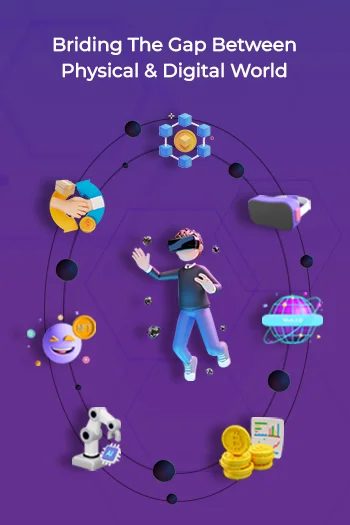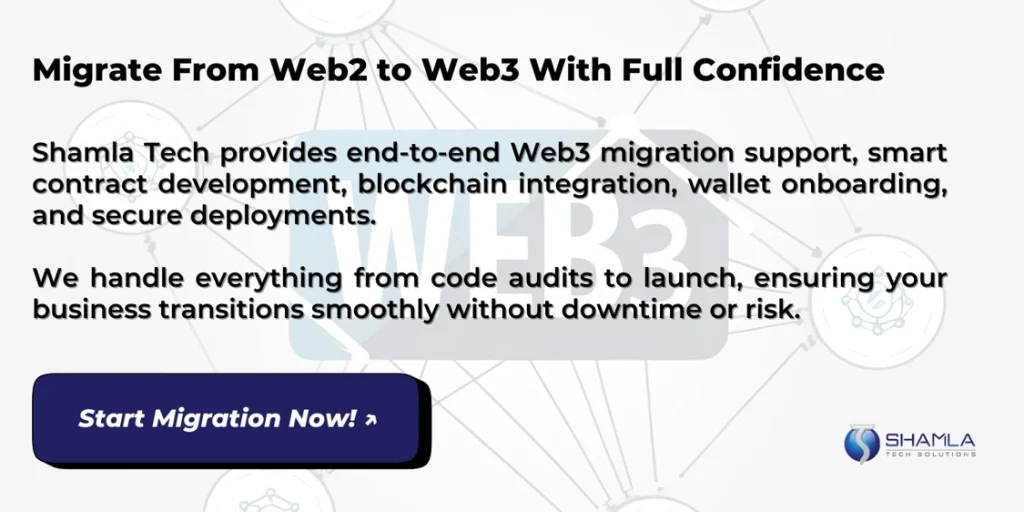
Understanding the Web2 to Web3 Shift
Web2 refers to websites that rely on servers managed by companies. In Web2, users give platforms control over their data and content, while Web3 uses blockchains and smart contracts to give that control back to the users. Key traits of Web3 solutions include decentralization, where no single party can alter records; smart contracts that run code automatically; and true ownership of digital assets. Many firms explore Web3 application development to add token models, on-chain identity, or decentralized finance features.
Businesses gain direct user engagement and transparent transaction logs. Web3 technology also offers interoperable systems where apps share data securely. This shift reduces middleman fees and increases user trust. Transition planning must balance current site functions with new decentralized modules. Decentralization means distributing data across many nodes so no central point of failure exists. Smart contracts are code scripts that run on blockchain networks once conditions are met. Ownership uses cryptographic keys that link assets to user wallets instead of platform accounts.
Web3 application development often uses languages like Solidity or Rust to write smart contracts. Many Web3 development companies offer toolkits and APIs for integrating wallets and tokens. Businesses can start by building simple NFT marketplaces or token gated content. Firms usually select Ethereum for its large user base or move to faster chains such as Polygon or Solana. Users always benefit from transparent audit trails. This approach reduces transaction costs and speeds confirmations.
Why Web2 Businesses Must Consider Web3 Migration Now?
Here are five major reasons to move from Web2 to Web3 now:
- Stronger Data Security: Web2 keeps your data on company servers that can be hacked or fail. Web3 technology stores records on blockchains, an unchangeable ledger – so only users with their private keys control access.
- Built-in Audit Trail: Every action on a blockchain is logged in real time. You can verify transactions or smart-contract calls without digging through separate logs or trusting third parties.
- Lower Hosting and Transaction Costs: Peer-to-peer networks replace expensive central servers. Using layer-two rollups and gas-fee batching cuts transaction fees and speeds up operations compared to mainnet alone.
- On-Chain Tokens and Identity: You can issue utility or loyalty tokens directly on-chain to reward users. Self-sovereign identity means users sign in with wallets (e.g., MetaMask) rather than passwords, reducing fraud.
- Early Mover Advantage: Adopting Web3 tools like Solidity smart contracts and testnet deployments now lets you shape best practices and meet new rules first. Waiting risks falling behind teams already hiring blockchain developers and setting standards.
Step-by-Step Web2 to Web3 Migration Blueprint
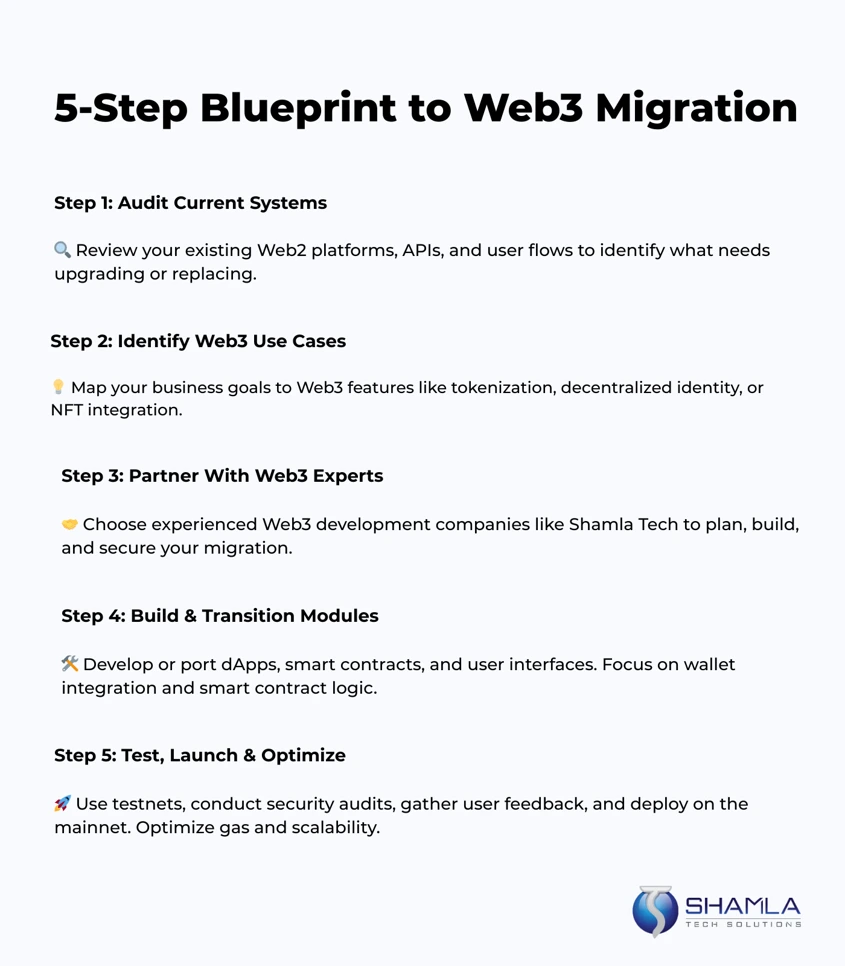
Step 1: Audit Existing Web2 Infrastructure
Audit your current Web2 setup. List servers, APIs, databases, and front-end frameworks you use. Check dependencies and plugins for each platform. Identify parts that store user data on central servers. Note performance metrics like server response time and uptime. Use log analysis tools to track traffic trends and identify error rates in real time. Review your authentication system to find where credentials live. Document all third-party services and their access levels. This report will guide which modules to rebuild or replace with blockchain equivalents. Track costs of hosting and data transfers. This will form your migration baseline.
Step 2: Identify Web3 Use Cases for Your Business
Identify Web3 technology use cases that fit your business. Consider tokenization for digital assets like loyalty or utility tokens. Explore decentralized identity for secure logins without passwords. Evaluate NFT integration for unique digital items or memberships. Look into decentralized finance tools for lending or staking features. Assess supply chain tracking with immutable blockchain records. For content platforms, plan token gated access. List use cases by priority and expected ROI. Estimate technical complexity and gas costs. Consult stakeholders to align with business goals. Use service providers to build prototypes. Define success metrics and timeline for each use case. Document dependencies on oracles.
Step 3: Partner with Web3 Development Companies
Choose a Web3 development company. Look for firms with smart contract experience in Solidity or Rust. Review portfolios to assess experience with DeFi, NFT, and token-based project implementations. Confirm they follow security best practices like audits and test coverage. Ask about frameworks such as Hardhat, Foundry, or Truffle.
Ensure they handle wallet integration with MetaMask or WalletConnect. Request their DevOps processes, CI/CD pipelines for contract deployment. Assess the team’s size and delivery speed to ensure they can meet your project deadlines effectively. Review case studies and client references for performance metrics. Confirm they can deploy on your selected chain, Ethereum, a layer-two network, or sidechain. Discuss pricing models, fixed versus hourly rates.
Check post-launch support, including bug fixes and upgrades via proxy patterns. Sign a detailed contract with deliverables, milestones, and maintenance terms. A reliable partner reduces migration risks. Verify their experience with oracle integration like Chainlink.
Step 4: Build or Transition with Web3 Application Development
Decide between full rebuild or phased migration. For full rebuild, rewrite modules as smart contracts. For phased, wrap existing services with blockchain adapters. Create smart contract interfaces that manage and respond to user actions effectively. Write contracts in Solidity or Rust, use code editors like VSCode. Run tests on local networks. Implement wallet login via Web3 libraries. Connect the front-end with ethers.js or web3.js. Keep data off the blockchain by storing it in IPFS or other decentralized file storage systems. For on-chain metadata, use token standards like ERC-20 or ERC-721. Manage upgrades with proxy patterns.
Develop the front-end using React or Vue, incorporating blockchain interactions seamlessly. Use state management to handle async calls and transaction mining status. Optimize gas by batching operations and minimizing loops. Integrate oracles for real-world data. Set up continuous integration to deploy contracts automatically. Ensure code style follows community linting rules. Document API endpoints and smart contract ABI for developer teams. Focus on making sign-in processes smooth and clear, with easy-to-understand error messages.
Step 5: Test, Launch, and Optimize
Test your new Web3 modules thoroughly. Run unit tests on smart contracts using frameworks like Mocha and Chai. Perform integration tests on testnets to simulate real conditions. Use automated tools for security audits, checking for reentrancy, overflow, and access control issues. Verify that wallet connections and transaction flows work as expected. Collect feedback from beta users through a test group or community. Fix bugs and optimize gas usage. Announce launch with clear instructions for users on how to connect wallets and interact with new features. Monitor performance and error logs continuously.
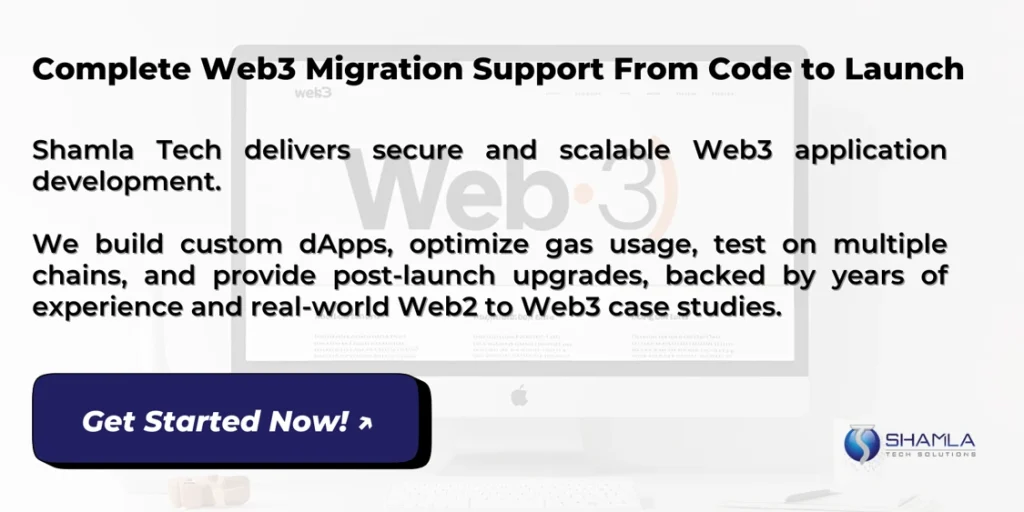
Challenges in Web3 Migration
- Unclear Token and Data Laws: Rules for on-chain tokens, security tokens, and data privacy differ by region. Teams must track token classification, KYC/AML rules, and data storage laws. Work with crypto lawyers, use on-chain governance models, and plan for dynamic rule updates without full redeploys. Consider using permissioned blockchains for regulated use cases and adjust compliance modules.
- Developer Skill Gaps and UX Hurdles: Finding engineers skilled in Solidity or Rust is hard. Teams need training, code samples, and coding standards. New users face wallet setup errors and confusing wallet UIs. Build simple wallet flows with clear error messages and step-by-step guides to boost adoption.
- Smart Contract Bugs and Gas Fee Spikes: Smart contracts need formal verification and third-party audits to catch reentrancy or overflow bugs. Unexpected gas fee surges on Ethereum mainnet can prevent users from completing transactions. Use gas optimisation patterns, batch operations, and layer-two rollups to keep transaction costs stable and fast.
- Cross-Chain Bridges and Decentralized Storage: Integrating with multiple chains adds complexity. Choose chains with secure bridges and test them thoroughly. Store large files off-chain using IPFS or Arweave, and run pinning nodes for data availability. Encrypt sensitive data before storing and managing keys securely.
- Continuous need of Testing, Upgrades, and Ongoing Support: Test on local blockchains and public testnets to catch network issues early. Design smart contracts with upgradeable proxy structures to allow updates without freezing users’ assets. Set up CI/CD pipelines for automated deployments. Offer support contracts, community channels, and regular training sessions and audits to resolve issues quickly.
Real-World Examples of Web2 to Web3 Migration
1. Starbucks Odyssey (Loyalty Program on Polygon)
Starbucks launched Odyssey, a Web3 loyalty program on the Polygon proof-of-stake chain for in-store and digital rewards. Members earn and buy NFT stamps called “Stamps” via Solidity smart contracts deployed on Polygon PoS. Users connect wallets with MetaMask or use credit cards for noncrypto participants. Smart contracts handle minting, transfers, and burn functions, all tested on Polygon’s testnet and audited by third parties. Gas fees are optimized by batch minting functions. On-chain metadata links to off-chain content. A custom front-end built with React and ethers.js tracks wallet events. Immutable NFT records unlock real-world rewards and exclusive experiences.
2. Reddit Community Points (Subreddit Rewards)
Reddit launched Community Points on the Ethereum mainnet to incentivize and reward active users within subreddits. Points tokens like MOON (ERC-20) and BRICK (ERC-20) run on Ethereum, later bridged to Arbitrum Nova layer-two for lower gas fees and faster finality. Smart contracts mint tokens based on on-chain upvotes and governance actions, secured by Optimism stack-based rollups. Community Points contract interfaces support staking, tipping, and in-platform purchases. Metadata and token supply use ERC-1155 for multi-token management. Front-end uses web3.js and WalletConnect for Ethereum and Arbitrum wallets. On-chain events trigger UI updates in real time. Immutable token balances empower users with self-sovereign community governance across networks seamlessly.
3. Nike .Swoosh (Digital Sneaker Platform)
Nike launched .Swoosh, a Web3 platform on Polygon that lets users buy, trade, and co-create digital sneakers in USD. The system records transactions in smart contracts written in Solidity and deployed via Hardhat. Users interact through .Swoosh UI integrating web3.js and Polygon Wallet. .Swoosh uses ERC-1155 token standards for virtual apparel and supports royalty splits automatically on secondary sales. Metadata and asset details are stored on IPFS, accessed through NFT metadata URIs. .Swoosh also offers a builder SDK for user-generated designs and API endpoints for marketplace integration. All trades settle on Polygon PoS with gas optimizations for seamless scaling today.
4. Ubisoft Quartz (In-Game NFTs on Tezos)
Ubisoft launched Quartz, a beta Web3 platform on the Tezos proof-of-stake chain for in-game NFTs called Digits. Quartz smart contracts use Michelson code and run on Tezos nodes, enabling players to own unique game assets in Ghost Recon Breakpoint. Developers saved Digit details on Tezos IPFS gateways and programmed smart contracts using FA2 tokens to mint both free and paid Digits. Front-end integration uses the Taquito library and Temple Wallet for user authentication. Automated CI/CD deploys contracts via Flextesa testnet before mainnet launch. Transaction fees stay low due to Tezos PoS consensus. Immutable on-chain Digits grant players true asset ownership directly.
Future-Proofing Your Business with Web3 Solutions
Adopt Web3 solutions with a long-term view. Track ROI by measuring token utility and platform growth. Prepare for protocol upgrades; follow community proposals and token holder votes. Invest in modular smart contracts to add features without system overhaul. Keep an upgradeable proxy pattern to patch bugs. Use layer-two scaling solutions to handle traffic spikes. Provide developer documentation and SDKs to help others easily build on your platform. Integrate analytics tools like Dune or SubQuery for data insights.
Align tokenomics to incentivize desired user actions. Regularly update user guides and code repositories. Participate in open standards groups to shape future protocols. Set aside a budget for researching and developing new Web3 technologies to stay competitive and innovative. Monitor competitor migrations and adapt strategies. Maintain clear communication with stakeholders about roadmap and governance. Shamla Tech can assist in setting up governance models and ongoing development plans. This prepares your business to leverage evolving blockchain tools and maintain relevance.
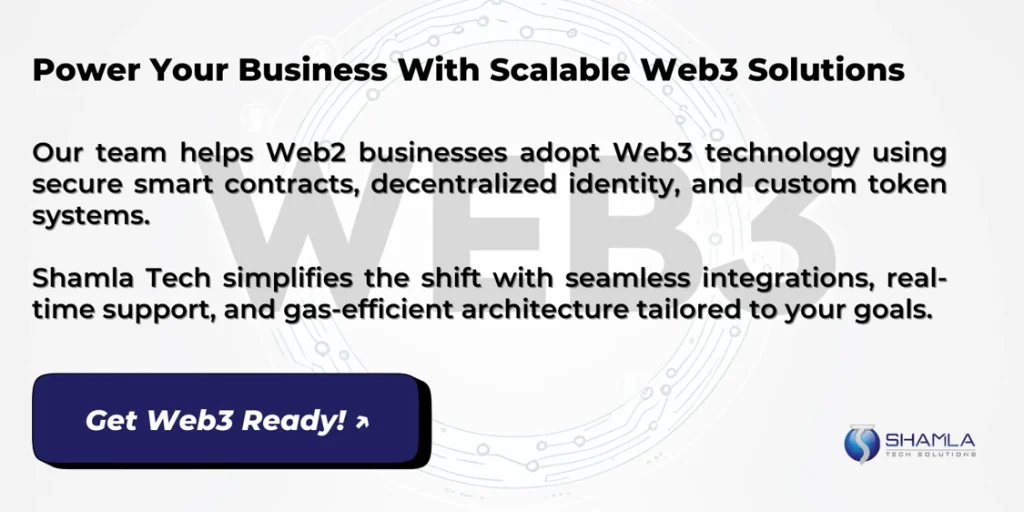
Conclusion
Web3 migration provides stronger data security, gives users control over their information, and opens up new ways for businesses to earn revenue. The shift removes platform lock-in and lowers fees with decentralized networks. Using Shamla Tech’s Web3 application development services and solutions will guide your business smoothly.
Shamla Tech is a Web3 development company which has helped clients worldwide implement token systems, smart contracts, and governance models. By following our blueprint: audit, identify use cases, partner with experts, build, test, and launch, you can easily migrate from web2 to web3 technology and keep innovating with governance and analytics tools.
Contact us today to start your Web3 migration and unlock blockchain benefits!


